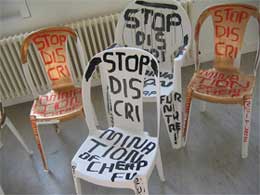 Second chapter of the report from Designing Critical Design, an exhibition of experimental objects and hypothetic projects for a consumer society currently running at the Z33 gallery in Hasselt, Belgium.
Second chapter of the report from Designing Critical Design, an exhibition of experimental objects and hypothetic projects for a consumer society currently running at the Z33 gallery in Hasselt, Belgium.
Exhibition number 2:
Marti Guixé defines himself as an ex-designer. The expression is meant to send a message that says that he can go beyond the boundaries traditionally assigned to the design discipline but without leaving totally that profession behind. It gives him more freedom of expression.
Guixé’s works investigates new product systems, a research which is best exemplified by the fact that he is responsible for making me associate shoes with food. Shoes because he designed some of the Camper shoe shops. And food because he’s also behind Camper FoodBALL healthy fast food restaurant. One of Guixé’s strength is actually interior design. He comes up with an innovative and very flexible concept for a shop and the idea can be repeated in different locations and countries. There used to be a Camper FoodBALL in Berlin but they recently closed it and now there’s just a bigger Camper shoe shop. 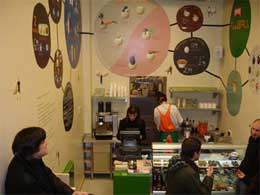
There were wide steps laid out like a grandstand were you could sit and eat as if on the stairs of a building in the street, except that you were inside. The food is organic (and consists mainly in yummy rice balls) and the shop itself is made using bio-construction.
Another of his culi-endeavour was Food Facility which he set up for a few weeks at Mediamatic (Amsterdam) in late 2005. The prototype restaurant’s kitchen was replaced by kitchens of existing take-out restaurants in the area. Guests sit at FF restaurant, make a choice from the menu of these take-outs and consume their order at Food Facility. That’s what Guixé called Post-Google Food!
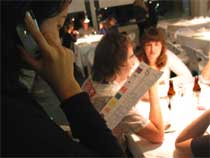
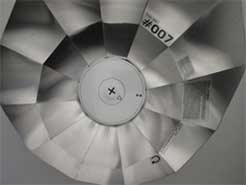 Food Facility and The Solar Kitchen-Building
Food Facility and The Solar Kitchen-Building
Back in 2003, he imagined for the MUDAC in Lausanne another contemporary way to enjoy food: Park Life reflects the fact that today cooking is more a hobby than a real necessity. Even so, it is still done mostly in a conventional kitchen. His series of Kitchen-Buildings are designed around the action and function of cooking in a “kitchen-city”. The Kitchen-Buildings can be installed separately or together, in generic, public or private spaces, making up an anthropological park in real time: park life.
However, Guixé doesn’t spend all his professional life into kitchens and restaurants. Demonstration:
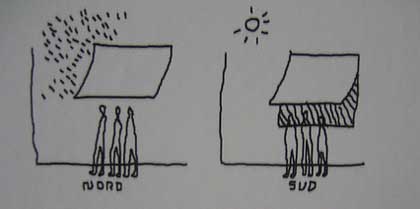
An Urban Post-it that could be easily removed and re-placed on any wall in the city to protect passersby from rain or sun.
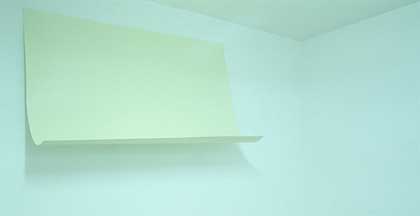 Urban Post-it (photo:Imagekontainer)
Urban Post-it (photo:Imagekontainer)
As a reaction to the Salone del Mobile and its seamingly endless capability to showcase so many new and sometimes so expensive chairs every year, Guixé presented in 2004 at Milan’s famous furniture fair the Skip furniture, a series of cheap plastic chairs that he covered with the words “Stop discrimination of cheap furniture” (image on top of this post.)
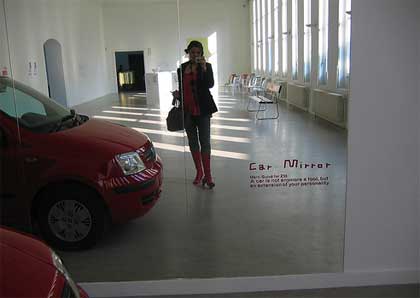
For the exhibition in Hasselt, Guixé designed 4 Car Mirrors. They are long and high like a big car and allow drivers to admire themselves in their cars as they pass beside one of them. In our society, car is not anymore a question of mobility, it’s rather an extension of one’s personality and image.
At the risk of disappointing some readers, i’m not going to delve much on Dunne & Raby‘s exhibition. I interviewed Tony Dunne last week and he explained in detail some of the works featured in Hasselt. Just a few highlights:
Jan Boelen, the curator of the exhibition, managed to gather in one place all the key works of D&R. Starting with a few Hertzian Tales (1994-1995) prototypes such as the iconic Faraday Chair, a domestic shelter from electromagnetic field or the Thief of Affection that steals radio signals from cardiac pacemakers. I had a big smile yesterday when i read about PerCushion: ten years ago Pillow Talk (present through a video in the gallery) did something similar. When it detects radio frequency signals stronger than the usual background, the pillow switches itself on, emitting patterns of light and distorted sounds.
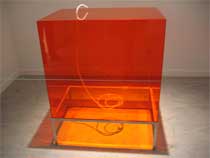
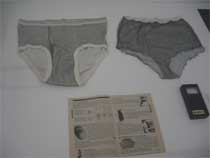 Faraday Chair and Protective Knickers
Faraday Chair and Protective Knickers
Placebo (2000-2001), eight prototypes to investigate people’s attitudes to electromagnetic fields in their homes, was occupying a whole room. Each of them was “officially adopted” and lived with a family long enough for people to start developing stories around the objects. My favourite of the group is the Electro-draught Excluder not only because i like pink objects to have impressively long names but mainly because it is what the designers call a “classic placebo”: it is not grounded and therefore cannot absorb radiation as its name implies. Simple technical facts like that one have never prevented me from: opening the windows to “improve” internet connection, putting my mobile phone BEHIND a stack of books on the bed table when i go to sleep, etc. You can also test the Phone Table at the gallery. Lift the table top and place your phone in the cavity with its ringer switched off. When someone calls you, the top of the table glows suggesting that electronic devices could use a more subtle approach to capture our attention.
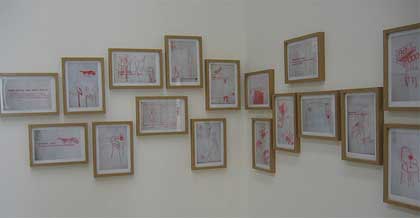
A series of sketches taken from Weeds, Aliens & Other Stories (developed in collaboration with Michael Anastassiades) that explores the passion that English people have for plants.
In the adjacent room is a couple of Huggable Atomic Mushrooms for people afraid of nuclear disasters and some examples of Hideaway Furniture, people scared of being abducted can hide inside them in a position of “control”. Design response to fear usually follows the road of either paranoia or denial. The Mushrooms and Furniture prototypes (developed in collaboration with Michael Anastassiades) propose to engage with anxiety in a rational way.
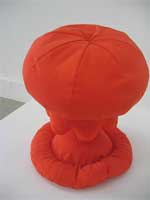
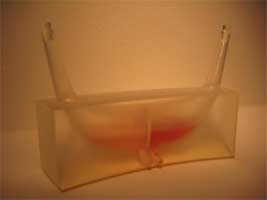 Atomic Mushroom and Robot Stomach
Atomic Mushroom and Robot Stomach
The robot models which each have unique psychological and social functions were presented in the above-mentioned interview. I’ll just add two words about the Robot Stomach. This one is inspired by current research which develop microbial fuel cells for robots, they use bacteria to “eat” slugs, meat, rotten apples and flies. In the future, some robots will work on “food” and thus have a stomach. How will the way we interact with them be affected when we have to feed them rather than recharge them?
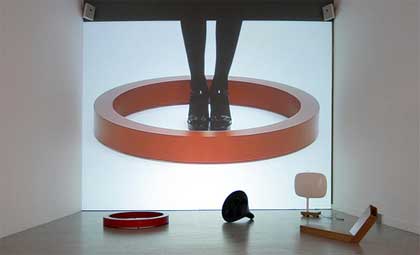 Robots (photo Kristof Vrancken)
Robots (photo Kristof Vrancken)
On May 7, at 7 p.m. the curators and designers will be giving a talk about their vision of critical design. You need to book but it’s free (info at z33 dot be)
More images from Marti Guixé and Dunne&Raby‘s pieces on flickr.
